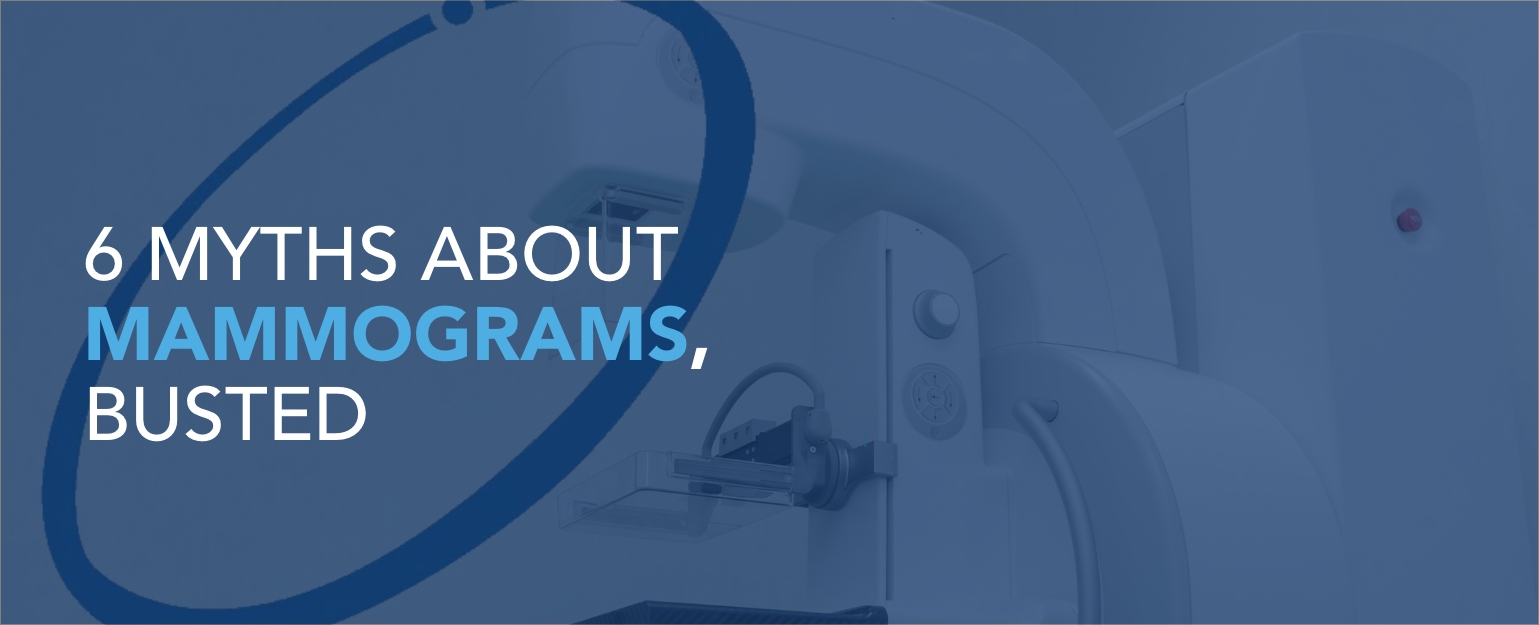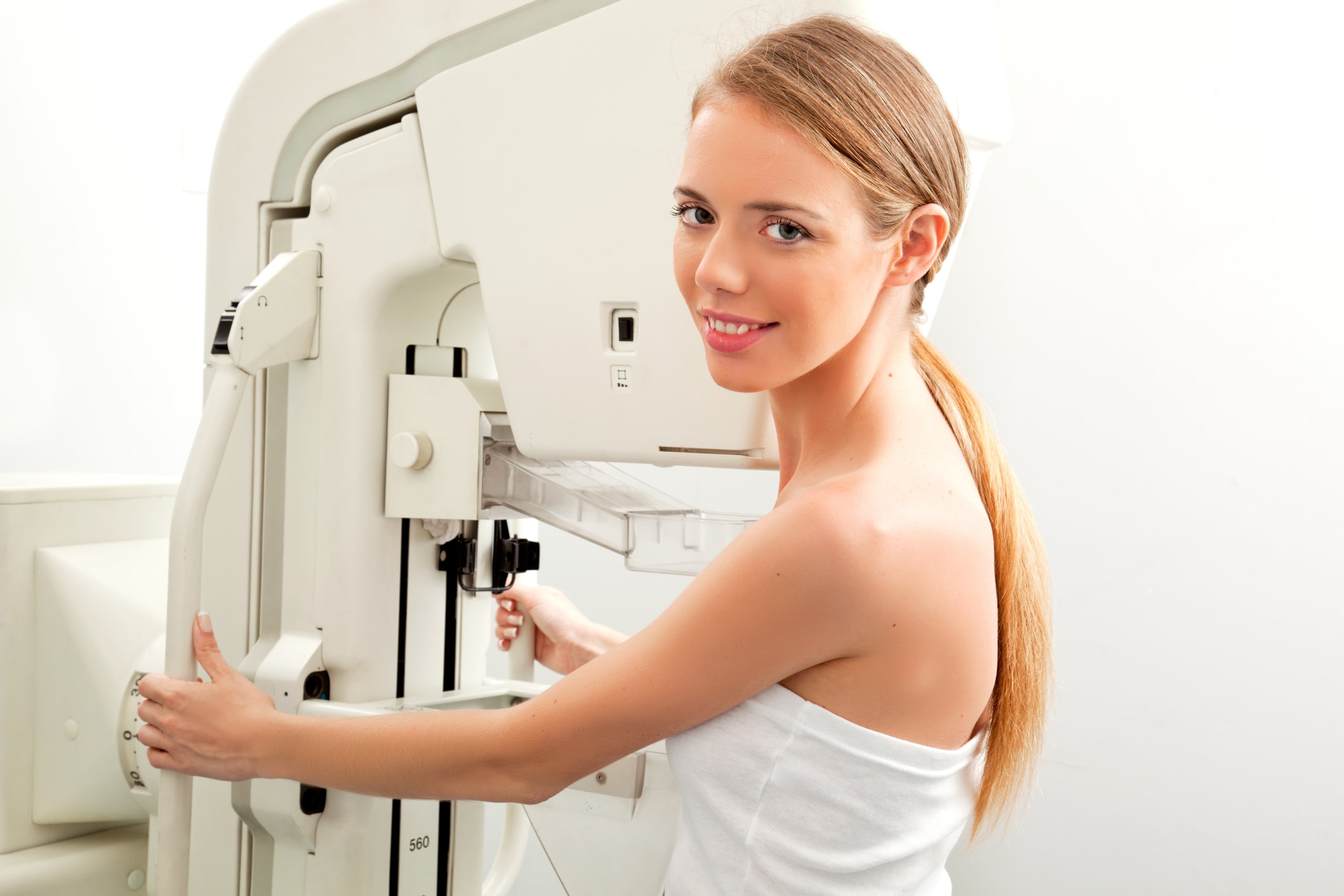6 Myths About Mammograms, Busted

Mammograms are one of the best ways to detect cancer early, yet mammography’s reputation might have some patients asking questions like, “Are mammograms dangerous?” “Are mammograms safe?” and “Do mammograms cause cancer?”
The spread of misinformation keeps people from seeking proper health care. Medical professionals have ensured the benefits of getting regular mammograms greatly outweigh any so-called harms.
These mammogram myths exist to instill fear in people, and that fear is dangerous, since it could result in people avoiding a routine health screening that can be the difference between catching and stopping the spread of cancer and undergoing months of exhausting cancer treatments.
Myth #1: Mammograms Are Dangerous and Painful
It’s no secret a mammogram involves trace amounts of radiation, but that amount is well within medical guidelines. Mammogram radiation exposure is very much like an x-ray, so mammograms are safe.
Radiation from mammograms is not enough to negatively affect your health, and it would be counterproductive for mammography to encourage cancer when it intends to spot and treat it as early as possible.
The mammogram myth about pain is a little more nuanced, since everyone’s pain threshold is different. Some people can find the pressure felt on the breast during a mammogram to be painful, but most find it to be mildly uncomfortable.
Myth #2: Mammograms Are Only for Those With a Family History or Symptoms of Breast Cancer
While it’s true anyone with a family history of breast cancer should be getting regular mammograms, so should everybody else. Cancer is a mutation of cells that can happen to anyone at any time, so regular mammograms are essential regardless. Indeed, about 85% of people who receive a breast cancer diagnosis have no family history of it.
If you have no family history of breast cancer, you should start getting mammograms once you turn 40. However, if you do have a history of breast cancer, especially in your immediate blood family, doctors recommend you begin getting regular mammograms 10 years before your relative received their diagnosis. For example, if your sister got diagnosed with breast cancer at age 43, you should start getting regular mammograms by age 33.
Waiting until you see symptoms of breast cancer can be counterproductive, since early detection is the best way to fight cancer. If there are already symptoms present, it could mean the cancer is more advanced and will be harder to treat.
Myth #3: All Mammograms Are the Same

Medicine has come a long way since the early days, and medical technology has been following suit. While we once had to rely on film mammograms, we now have the technology of 3D mammograms, which allow medical professionals to get a more detailed view of the breast tissue than traditional 2D mammograms did.
The detailed picture from a tomosynthesis mammogram, the technical term for a 3D mammogram, allows medical professionals to better spot more abnormalities. The 3D image gives a better idea of what the tissue and cells look like than a flat, 2D mammogram allows. The increase in the visible details allows doctors to spot cancer far earlier, and also reduces the likelihood of a false positive or false negative.
3D mammography has proven to increase the chances of detecting cancer early — even for those with very dense breast tissues — by 40%. 3D mammography also reduces the chances of a false alarm or an unnecessary callback by 40%.
Myth #4: A Callback After a Mammogram Means Cancer Is Certain
The symptoms of breast cancer are tricky because they can also be symptoms of benign issues, like cysts. More often than not, doctors will call patients back for further tests to get a better look at the breast tissue.
With a 2D mammogram especially, the results are flat and don’t allow for as much depth as 3D mammograms do, so doctors may request further tests, like MRIs or biopsies, to be on the safe side.
Fewer than 10% of people who get called back after a mammogram end up receiving a cancer diagnosis, so, while a callback can be scary, more often than not, it’s just the doctor being extra sure.
Myth #5: Mammograms Will Always Detect or Prevent Cancer
One of the most misleading myths about mammograms is that they are foolproof and will always be able to detect the early phases of cancer. While mammograms are the best diagnostic tool to spot the stages you can’t see or feel, it does have its limitations.
Dense breast tissue can both hide signs of cancer and mimic them, so while 3D mammography is an improvement over 2D mammography in spotting the difference, doctors may sometimes need to call you back for further testing, just to be completely sure there’s nothing to worry about.
Your doctor could send you to get a breast MRI or breast ultrasound to get a better look at the breast tissue and make a more learned diagnosis.
Unfortunately, even with the best technology at our fingertips, cancer is not something we can 100% prevent. However, regular mammograms are the most useful tool we have today to detect early stages of cancer, which are far easier to treat than advanced cancer.
Myth #6: Self-Exams Are as Effective as or Made Redundant by Mammograms

Self-exams are an excellent way to get familiar with your breasts and know what is normal for them, which makes it easier to spot any changes sooner. However, they are not a replacement for mammograms, nor are mammograms a replacement for self-exams.
Both work best when used together for optimal effect. You should be getting a mammogram every year at least, but you should be doing self-exams every month. They’re an excellent way to be familiar with your body and what’s normal for it. For example, some people have very sinewy breast tissue that can feel lumpy, so a doctor performing a breast exam during an annual physical may find that worrisome until the patient explains it’s normal for them.
If you find something strange during a self-exam, you can make an appointment with your health care provider and get the abnormality checked out straight away.
Schedule Your Mammogram With Clear Connect Medical Imaging
Contrary to popular belief, a doctor’s referral is not necessary to schedule a mammogram. We at Clear Connect Medical Imaging pride ourselves on the compassionate care we provide and our goal to improve lives through unmistakable quality and spectacular service. With the top technology and staff, we are revolutionizing diagnostic imaging.
Get in touch with us at any of our locations and book your mammogram today.
Call To Schedule Your Appointment
Sources
- https://www.osfhealthcare.org/blog/top-5-mammogram-myths/
- https://www.breastcancer.org/symptoms/understand_bc/statistics
- https://www.hopkinsmedicine.org/health/conditions-and-diseases/breast-cancer/6-mammogram-myths
- https://clearconnectimaging.com/signs-and-symptoms-of-breast-cancer/
- https://www.cancer.org/cancer/breast-cancer/screening-tests-and-early-detection/mammograms/getting-called-back-after-a-mammogram.html
- https://www.nationalbreastcancer.org/breast-self-exam
- https://clearconnectimaging.com/services/mammography/
- https://clearconnectimaging.com/locations/



